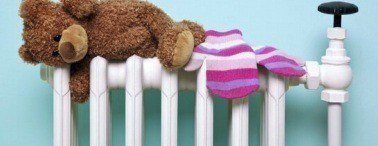
One of the latest buzzwords in energy generation is "biofuels," and nowhere is this more evident than in homes using heat from outdoor furnaces. These units are basically wood-fired boilers housed inside sheet metal sheds. The only difference between these and oil-fashioned hot water systems is that the heat source and the place to be heated can be as much as a hundred yards apart.
The outdoor wood burning furnace, or OWB's, can heat either glycol or water from an isolated spot on the property where the liquid is then pumped through insulated pipes to the home. Once inside the hot liquid can be used to provide heat in a few ways:
1. Liquid-to-Liquid Heat Exchanging: In this system the heated liquid enters a large storage tank containing coils of copper tubing. Water in the tubing is heated and this flows through the home's hot water baseboard system (hydronic) and supplies the home's domestic hot water needs.
2. Direct Heat: When the heated liquid enters the home it goes directly into the home's hydronic system and indirectly heats the domestic hot water in a separate system.
3. Hot Air Radiator: The heated liquid can also be pumped into special radiator inside the plenum of a forced-air system. Using the ductwork of an existing HVAC system the radiator transfers the heat to the air which is then distributed by the furnace fans when the thermostat comes on.
All OWB's systems are "closed loop," meaning that the cooled liquids return to the heat source via a return tube to be heated again. In a direct hot-water system some new water is added due to evaporation.
Many Types of Fuels
Most outdoors furnaces in Canada burn wood that is cut in four-foot lengths. The firebox is loaded up either once or twice a day depending on the heat load and the burn rate is also set. To make this transference of the heavy fuel easier many owners build a shelter for the wood along with a loading table to slide the logs into the firebox.
Outdoor furnace units can burn all types of wood products from chips to logs. However, they can also burn almost any combustible substance including most types of garbage. The most common fuels are four-logs as they do not need to be split or dried. This makes them almost half the price of seasoned and split fireplace wood. However, a blend of both softwood and hardwood brings the price down lower and two of each type of log will keep a 2,500 foot home warm on a cold winter's day.
Outside Furnace Advantages
1. Cost of Fuel: OWB's can burn all types of scrap wood, waste wood, brush and dried agricultural products.
2. Lower Insurance Rates: Since OWB's are situated well away from homes and outbuildings there is no chance of an accident like a fire. The burning units are insulated and cool to the touch so any dry vegetation around the shed will not be affected. In addition, the exhaust does not give off hot airborne particles that could start brush fires. This all adds up to lower insurance rates.
3. Carbon Monoxide-Proof: Odor-less carbon monoxide from leaks in gas, oil and wood-burning appliances kills hundreds of people every year. The outside placing of the heating unit takes this threat away.
4. Clean Indoors: It doesn't matter if a home has a wood-burning fireplace or a wood pellet stove there will always be dust particles. Since OWB's are connected to the home by underground tubing there is no chance of excess dust and dirt.
The Cost of Outdoor Furnace
A study of outdoor wood furnaces in the United States proved that the average OWB in that country used 10-13 cords of wood a year depending on the mix of hard or softwood. At an average price of $115 a cord for unseasoned hardwood cut in four-foot lengths, the heat and hot water bill for a 3000+ sq. ft. home would be less than $1400 per year. This is even less with the addition of scrap wood.
In some parts of the Canadian prairie regions ranchers, farmers and other commercial operations dealing with scrap wood as a byproduct heated their buildings with available byproducts. In fact, one furniture plant in southern Nova Scotia heats its buildings entirely on sawdust and wood scraps.
Setting up an OWB can cost from $8000 to $13,000 depending on the size of the area to be heated, the cost of excavation for the underground pipes costs and extras: shelter; loading table; extra hardware. If you already have an existing heating unit this can be used as a backup in case, for some reason, the OWB malfunctions.
For more information on outdoor furnaces in your area consult our Contractor Directory or post your project online.
Posted by: Kim Kinrade





